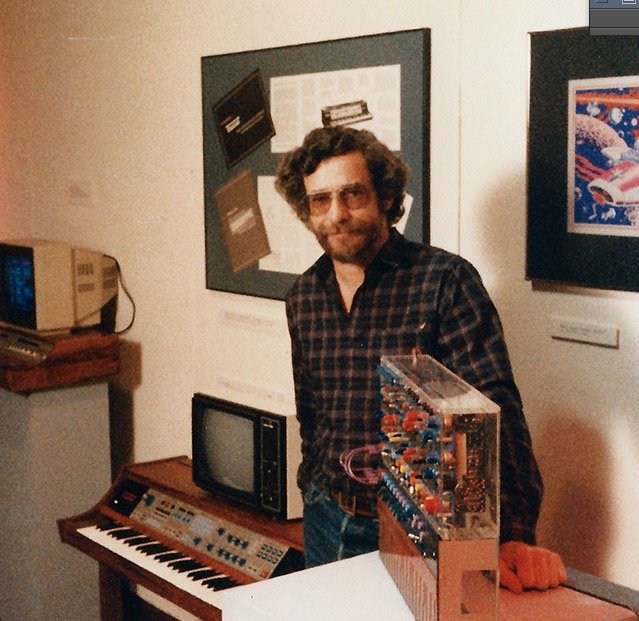"
Knobcon, the world's only synthesizer convention, returns to the Hyatt Regency Schaumburg near Chicago IL USA for the fifth happening of this immersive event featuring over 60 exhibitors, live performances and workshops!
Knobcon:
Jack to the Future Part V
$35 Entry Fee for ALL 3 DAYS!
Optional Knobcon Banquet only $50
It all begins with an opening reception on Friday, September 9 with live performances by Allerian, Entanglement, Studio Dummies, and Suit & Tie Guy. Attendees of the reception will also enjoy specially priced drinks featuring whiskey from Balcones Distilling.
Multiple exhibit halls open to the public at 10AM Saturday and Sunday and are filled to capacity with large manufacturers such as Roland, Korg, Yamaha, and Moog, the finest boutique modular and pedal companies, and even some "classic cars" that collectors bring to display. Behringer’s new analog polysynth DeepMind12 will be making its North American debut at the event. Also appearing will be the new Minimoog Model D from Moog, and Arturia's Matrixbrute. See the latest releases and even purchase gear at special Knobcon pricing throughout the weekend!
Workshops scheduled on Saturday and Sunday, Sept 10-11. See the Knobcon website (www.knobcon.com) for complete descriptions and times.
• Syntheizer Basics and Synthesizer Myths presented by Marc Doty
• History and Theory of Additive Synthesis presented by Jon Sonnenberg
• Birth of the Prophet VS presented by Chris Meyer
• Tomita: A Voyage Through His Greatest Techniques presented by Nicholas D. Kent
• Experimental Music: Composition with an Arduino MIDI Controller presented by Elliott Inman
• MIDI: What’s it All About? presented by Amos Gaynes
• BeatPPL - Live Podcast Recording
• SynthSummitShow - Live Podcast Recording
• Learn to solder SMT with synthCube building a Buffered Mult and Cable Tester Module
• Build an AstroNoise Euro Module or Standalone Circuit with Synthrotek
• Build a Dual Passive Low Pass Gate Euro Module with Modular Addict
Saturday evening features multiple events including the annual Knobcon Banquet with a keynote address by guest of honor, Bill Hemsath. Enjoy cocktail music by the Knobcon Supper Club All-Stars, a classic organ, guitar, and drums trio.
Bill Hemsath, RA Moog's Chief Engineer from 1969 to 1971, gave us three fantastic things we all treasure to this day. He developed the first CV joystick, which then became pitch and mod wheels. He also had the bright idea to wire some modules together in a box with a keyboard, and the Minimoog was born.
The entertainment continues Saturday night with multiple live music events. The Knobcon Big Room - a house and techno party with projections by Lorenzo Vektor and Dennis Stein. Big Room performers include Glacial 23, Introvert, Low-Gain, Komprezzor and Oliver Dodd. If that's not your thing, head over to the International Players Club - a live music and jam session with The SynthFreq & Friends.
Knobcon ends on Sunday, September 11 at 5pm.
Full event details can be found at
www.knobcon.com
EXHIBITORS
2hp, 4ms Company, Amplified Parts, Analogue Solutions, Antimatter Audio, Art For The Ears, Artisan Electronic Instruments, Arturia, Audient, Behringer, Believotron, Black Market Modular, Blue Lantern Modules, Casio, Detachment 3, Detroit Modular, Division 6, Dreadbox, EarthQuaker Devices, Elite Modular, Erogenous Tones, Evaton Technologies, EVE Audio, Future Retro, Foxtone Music, Grove Audio, Hexinverter Électronique, Industrial Music Electronics, Kilpatrick Audio, Korg, KVgear, Malekko Heavy Industry, Metalphoto of Cincinnati, Modal Electronics, Mode Machines, Moog Music, Moon Modular, Modular Addict, Nerd Audio, Noisebug, Novation, Old Crow, Percussa, Perfect Circuit Audio, Plastiq Musiq, Qu-Bit, Reverb, Roland, Sleepery Supply, STG Soundlabs, Syinsi, synthCube, Synth City, Synthrotek, Synthesis Technology, Tsyklon Labs, Verbos Electronics, WMD, Yamaha, Zetaohm, Żłob Modular, Z. Vex Effects"



















































